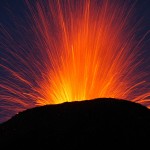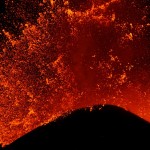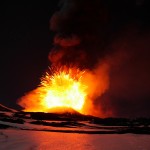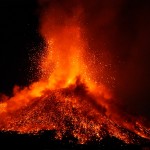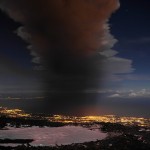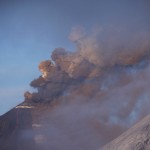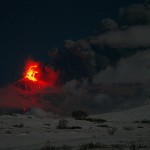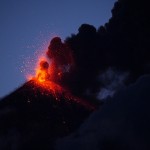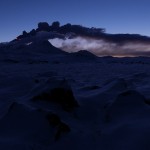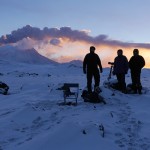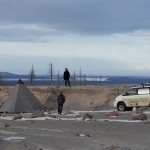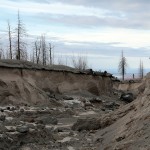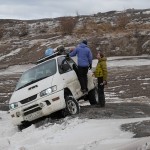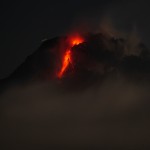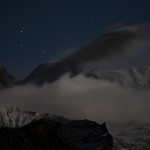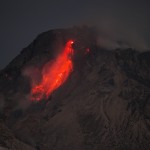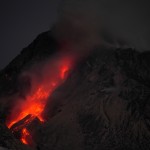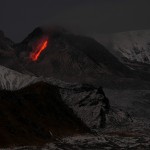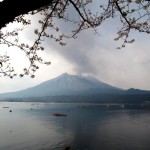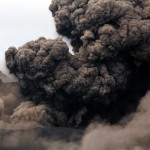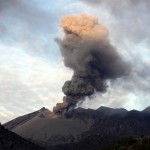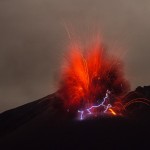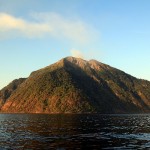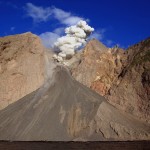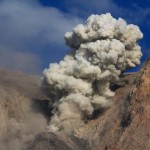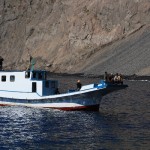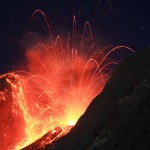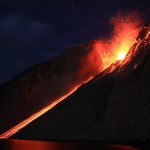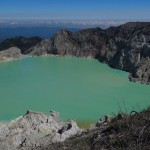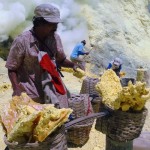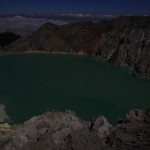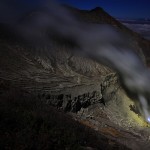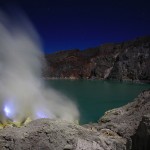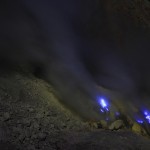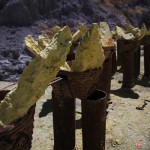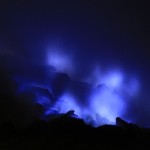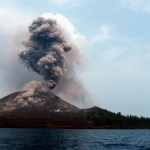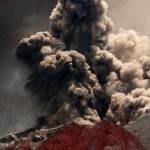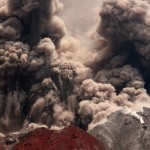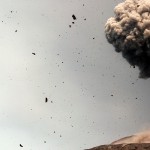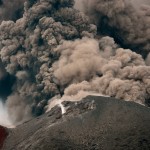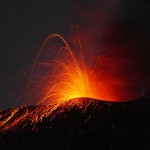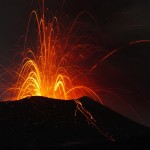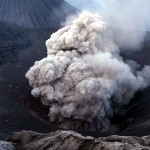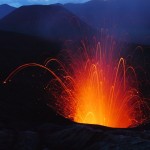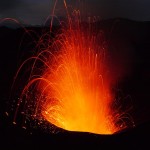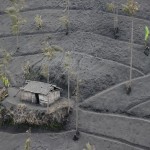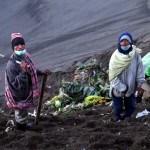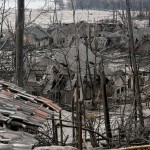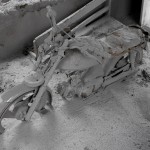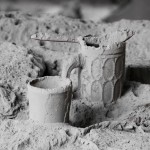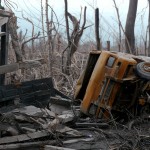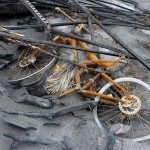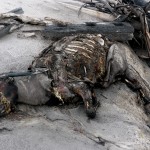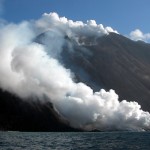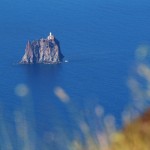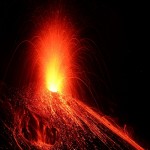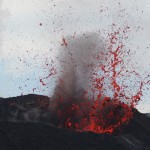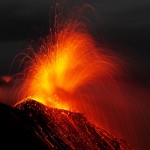The paroxysmal eruption of Mount Etna appeared in the night between 16th and 17th November 2013. It was the 16th paroxysm this year. I travelled with the Geonauts Martin and Thorsten. We spend the night in our tents close to the rim of “Valle del Bove”, in a distance of 2 km to the active crater. The duration of the eruption was longer than it of most other paroxysm and less nearby all the night. Some spectacular lava bubbles were erupted. Two lava flows streamed to the southwest and southeast. These flows were not so long like others before.
 Marc Szeglat
Marc Szeglat
Klyuchevskoy: Video
Eruption of Klyuchevskoy in Kamchatka. Video clip made between 15th and 20th October 2013.
Kamchatka: Klyuchevskoy and Sheveluch
The Russian peninsular Kamchatka is the land of volcanoes. During our journey between 14th and 26th October 2013 Martin, Richard and Marc visited the active volcanoes Klyuchevskoy and Sheveluch. The former one erupted first time since 3 years. During its strongest phases the explosions from Klyuchevskoy were heard at a distance from 30 km. Lava fountains rose up to 1 km above the summit.
Sheveluch volcano shows slight dome growth, accompanied by lava avalanches and small pyroclastic flows. One day before we reached the volcano, there was a bigger eruption with ash clouds up to 10 km altitude.
Sakurajima: eruptions and volcanic lightning
Sakurajima is one of the most active volcanoes in Japan. The volcano is in a stage of continuous eruptions since 2009. Most of them are from strombolian type, but some are more powerful vulcanian eruptions. In the ash clouds of these eruptions volcanic lightning occurs more often than on other volcanoes.
Batu Tara: island of taboos
Batu Tara is a small strato volcano close to the coast of Flores in Indonesia. Batu Tara is located on Komba Island. It’s an inhabitant Island, the spirits of the death living on. That is the reason why komba is taboo for some Indonesians.
Batu Tara is similar to Stromboli in Italy. Its frequent eruptions are from same type. The eruptions occur every 10 to 20 minutes. Scoria rolls over the flank of the volcano into the sea.
Kawah Ijen: burning sulfur and blue flames
Kawah Ijen is a well known Volcano in east Java. In its summit crater lies an acid lake and on the shoreline of this lake degases many fumaroles. The fumaroles transport tones of sulfur from earth interior to its surface. The sulfur condenses close to the fumaroles and thick layers of the yellow mineral solidify in one part of the deep crater. Every day hundreds of miners climbing down the crater and dig the sulfur. In two baskets they carry the minerals to a weight station, 3 km downhill.
Anak Krakatau: “child of Krakatau”
Anak Krakatau is the “child of Krakatau”. The new island growth up since 1926 and established a small stratovolcano in the caldera formed after the disaster from 1883. In this year the former island Krakatau destroyed itself in a very huge eruption. Tsunamis, caused by the collapse of the volcano, killed more than 36.500 people.
The eruptions of Anak Krakatau are not so disastrous like the one in 1883, but still power full enough, to threaten observers close to the volcano. In 2010 Chris and I visited Anak Krakatau and we spend 2 nights on the island. Vulcanian explosions threw lava bombs above our heads, smashed into the sea. An adventure we will never forget.
Bromo: Gods and eruptions
Mount Bromo is a volcano in central Java. The last eruption was in 2011, when the volcano was active for many months. The landscape was covered by volcanic ashes. The plants on the fields withered and the airport of Surabaya was closed on several days. But 3 months after the eruption the Kasada celebration was hold. Many Hindus climbed the crater rim and sacrificed animals, vegetables and fruits to their god Brahma.
Merapi
Eruption of volcano Merapi in 2010. Pyroclastic flows destroyed several villages. I visited Merapi together with Chris Weber from VEI.
Chronicle of an eruption
The eruption of the Merapi volcano was one of the most significant eruptions of 2010, which became a natural disaster, killing more than 250 people. The economic damage is enormous and the ash deposits destroyed numerous plantations. It will take years until the palm trees bear fruit again.
The first indications of the volcano awakening were already at the end of August / beginning of September. The Merapi emitted more gas and a slight earthquake activity started. The government began to rehabilitate roads and bridges so that the population could be evacuated quickly in case of emergency. The chronicle shows how the volcanic eruption developed:
September 22nd: Increase of the warning level to yellow.
October 11: First sighting of glowing lava at the dome of the volcano.
October 19: Almost daily activity increases at Merapi on Java. On Monday, 60 lava avalanches were registered, which descended towards Kaliurang. Tremor (357 events) and volcanic quakes (43 events)
October 21: Blocking of the ascent. The volcanologists were concerned about the increasing pressure under the volcano. The inflation rate was exceptionally high.
25 October: Increase of the warning level to orange. This is the highest warning level before an eruption. The magma is now only 1 km below the crater. A 10 km exclusion zone was established and several villages were evacuated.
October 26: First dome collapse triggered pyroclastic flows which destroyed the village of Kinahrey. 7 people died and at least 14 were injured. An eruption cloud rose several kilometers high. There were numerous explosive eruptions that lasted up to 33 minutes. Volcanic bombs struck within a radius of 1.5 km around the dome. In the following days there were more eruptions, but they were smaller. Alarm status red was declared.
3 November: A large explosion followed by a partial collapse of the dome. Pyroclastic flows covered a distance of 10 km and an ash cloud rose several kilometers high. The eruption lasted for over an hour. The safety zone was extended to 15 km and tent camps with the evacuees had to be moved further. Photos showed that a large part of the old dome was blown away. A large block slipped onto the southern slope just below the summit and remained there for the time being.
5 November: Further heavy explosions mobilized the rest of the old cathedral, including the block on the southern slope. A new crater was formed. Pyroclastic flows destroyed the village of Argomolyo, 18 km from the summit. The village burned down in part. The village of Cangkringan 15 km away was also severely affected. More than 250 people died and 66 people were injured. Many victims were only recovered days after the disaster.
The security zone was extended to 20 km, more than 100,000 people were on the run.
09 November: The activity decreased. There were still isolated pyroclastic flows. Rainfall increased the danger of lahar.
11 November: Chris Weber and I reach the Merapi (see report Merapi)
November 14: A lahar flowed through the Bebeng River.
November 17: The activity had decreased so much that we dared to climb up to the steaming crater.
30 November: A lahar caused the river Code to overflow its banks and the mud flooded several houses. 400 people had to flee.
December 04: Activity continued to decline sharply. Downgraded to warning level Orange
A total of 320 people died in this volcanic eruption.
Stromboli: Lighthouse of the Mediterranean
Stromboli is a very popular volcano in the Mediterranean Sea and known by the ancient Roman as “Lighthouse of the Mediterranean”, because of its long-lasting strombolian eruptions.
This picture gallery shows the evolution of the volcano since its last flank eruption in 2007 until 2013.
